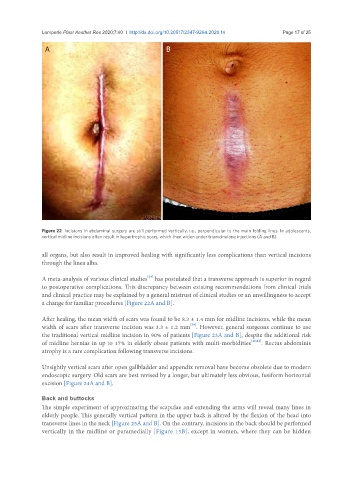Page 448 - Read Online
P. 448
Lemperle Plast Aesthet Res 2020;7:40 I http://dx.doi.org/10.20517/2347-9264.2020.14 Page 17 of 25
A B
Figure 22. Incisions in abdominal surgery are still performed vertically, i.e., perpendicular to the main folding lines. In adolescents,
vertical midline incisions often result in hypertrophic scars, which then widen under triamcinolone injections (A and B)
all organs, but also result in improved healing with significantly less complications than vertical incisions
through the linea alba.
[39]
A meta-analysis of various clinical studies has postulated that a transverse approach is superior in regard
to postoperative complications. This discrepancy between existing recommendations from clinical trials
and clinical practice may be explained by a general mistrust of clinical studies or an unwillingness to accept
a change for familiar procedures [Figure 22A and B].
After healing, the mean width of scars was found to be 8.3 ± 1.4 mm for midline incisions, while the mean
[39]
width of scars after transverse incision was 3.3 ± 1.2 mm . However, general surgeons continue to use
the traditional vertical midline incision in 90% of patients [Figure 23A and B], despite the additional risk
of midline hernias in up to 17% in elderly obese patients with multi-morbidities [40,41] . Rectus abdominis
atrophy is a rare complication following transverse incisions.
Unsightly vertical scars after open gallbladder and appendix removal have become obsolete due to modern
endoscopic surgery. Old scars are best revised by a longer, but ultimately less obvious, fusiform horizontal
excision [Figure 24A and B].
Back and buttocks
The simple experiment of approximating the scapulae and extending the arms will reveal many lines in
elderly people. This generally vertical pattern in the upper back is altered by the flexion of the head into
transverse lines in the neck [Figure 25A and B]. On the contrary, incisions in the back should be performed
vertically in the midline or paramedially [Figure 13B], except in women, where they can be hidden

